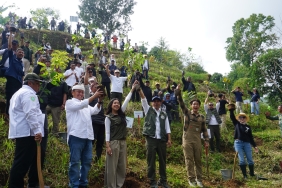REVIVING CUSTOMS AND CULTURE IN THE STYLE OF KEDUNGKANG VILLAGERS
By: Shella Rimang
Journalist Suara Pemred
This article was written in conjunction with the Lake Sentarum Festival 2018 Pre-event
Lake Sentarum seems to be more than just a lake that connects various regions in Kapuas Hulu, it also connects people from different backgrounds. People who live in the lake are closer to fish, while people who live on the shore of the lake are closer to forest products, for example the residents of Kedungkang Hamlet, Sepandan Village, Batang Lupar District.
Kedungkang Hamlet residents who live in betang or long houses, use wood from the surrounding forest to build betang. The betang, which they have lived in since 1987, was only renovated in 2017. Despite the renovation, the materials of the betang house still use wood to maintain the authenticity of the Dayak culture. The most dominating wood is ulin (belian) wood. The appearance can be seen starting from the floor, walls, to the roof of the betang.< br />
Therefore, the last hamlet on the coast of Lake Sentarum, located in Batang Lupar District, is often the destination of tourists. Every day, there are still at least 2-3 tourists visiting the hamlet which has two betang with a face-to-face position. The nature lovers' destination is on a hill, before entering the hamlet. The hill is called Bukit Babi, for some reason. The panorama presented on the hill is truly different from its name. From the green weeds, you will see a beautiful and eye-pleasing view of Lake Sentarum.
In addition to Bukit Babi, there is also Kedungkang Bridge, which is positioned right next to the betang. This position is very beneficial for tourists because they can visit two places at once: visiting the betang and circling the 700-meter-long bridge. The bridge, which is in the process of being added, will directly connect the betang and Lake Sentarum when the lake water is high. "Later, there will also be an entertainment stage and a place to relax for visitors," said Lom, Tuai Rumah and Head of Kedungkang Hamlet, last Thursday (27/9).
Despite receiving frequent tourist visits and interacting with foreigners, the hamlet residents remain loyal to local wisdom and culture. They, who are mostly farmers, are not tempted by the times. Although they open land for farming, they will reforest it with plants that produce, such as durian, jengkol, and rubber. They will clear the land as necessary to plant rice and corn, but still keep forest fires at bay.
Anticipating that land fires will not occur, for those who farm, the residents of Kedungkang Hamlet agreed to make customary law. The customary law is in the form of compensation for burned plants. One burned tree will be compensated by the burner, depending on the type and diameter of the tree. "The customary law has not really been listed (written-ed). Usually Rp.25,000 per trunk for rubber. Durian is different, it can be millions," said Lom.
The existence of customary laws that ensnare, balanced with fair customary regulations. For example, when villagers want to take ironwood trees to repair damaged buildings, the villagers will go to the forest together, cut down the trees, and transport the results to the betang. Then, the ulin wood that has been processed will be divided equally per betang. "For ironwood because it is difficult to obtain, there is usually a division of wood products. For example, if ironwood is made into a roof. The roof will be divided equally, let it be only five pieces per family," said Lom.
A day spent working in the fields or in the garden does not diminish the friendliness of the people of Kedungkang Hamlet. In fact, they have been preparing for the Lake Sentarum Festival from afar. Residents have prepared various kinds of handicrafts, such as woven fabrics that use natural dyes from plants and forest fruits. "If you use natural dyes, if it gets wet, it will not fade. If the dye is artificial, it will fade easily," said Lom.
In contrast to the woven fabrics that are usually done by women, there are male residents who make parangs, sickles (traditional carrying bags made of rattan, usually used to transport natural products), and uyut aka traditional round-shaped carrying bags, also made of rattan. Residents are enthusiastic about the festival, which will be held at the end of October. Moreover, Kedungkang Hamlet is also one of the hosts of the dragon boat/bidar race.
There are several reasons, Kedungkang residents are so enthusiastic about welcoming the festival titled Heart of Borneo initiated by three countries: Indonesia, Malaysia and Brunei Darussalam. First, they want to show their identity. Second, to revive their customs and culture. "In the past, our customs were almost extinct. But because of the encouragement from various parties, including WWF-Indonesia, our customs and culture came back to life," concluded Lom.





